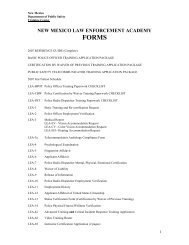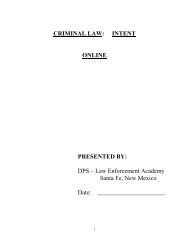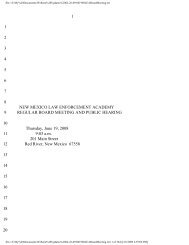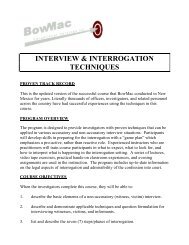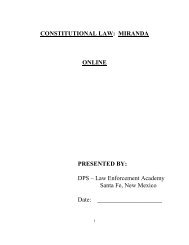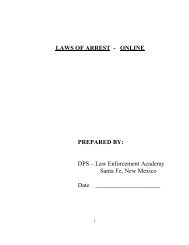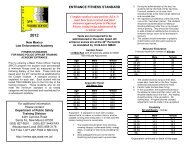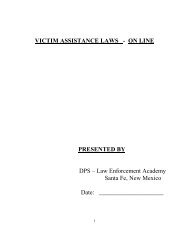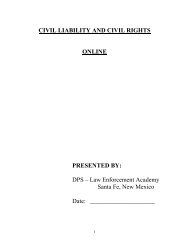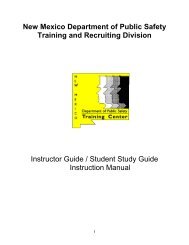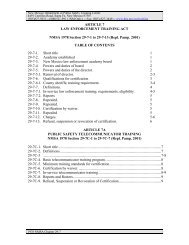10.29.1 nmac 1 title 10 public safety and law enforcement chapter ...
10.29.1 nmac 1 title 10 public safety and law enforcement chapter ...
10.29.1 nmac 1 title 10 public safety and law enforcement chapter ...
Create successful ePaper yourself
Turn your PDF publications into a flip-book with our unique Google optimized e-Paper software.
(3) Curriculum developed by the training <strong>and</strong> recruiting division will be provided to individual<br />
agencies upon request for their own certified instructors to present to their officers, provided the instructor is<br />
qualified in the subject matter. Recommended training topics include: human trafficking investigations (curriculum<br />
developed by the New Mexico attorney general’s office), <strong>and</strong> legal update (curriculum developed by the advanced<br />
training bureau).<br />
(4) Individual agencies develop curriculum for review <strong>and</strong> approval (accreditation) by the academy<br />
which meets the criteria established by the board.<br />
C. This four-pronged approach gives all agencies the flexibility they need to address individual<br />
training needs. It also allows the board to implement a planned program of in-service training that is responsive to<br />
the changing dem<strong>and</strong>s placed upon <strong>law</strong> <strong>enforcement</strong> <strong>and</strong> the opportunity to have statewide consistency in certain<br />
critical areas.<br />
D. Implementation is to begin on January 1, 20<strong>10</strong>.<br />
E. Officers obtaining certification between, January 1, 20<strong>10</strong> <strong>and</strong> December 31, 20<strong>10</strong>, will be<br />
required to obtain one-half of the in-service training requirements. Officers obtaining certification between, January<br />
1, 2011, <strong>and</strong> December 31, 2011, will be required to meet the next two-year requirement which will go into effect<br />
on January 1, 2012. This policy will apply in subsequent two-year cycles. Officers transferring from one agency to<br />
another will carry with them the responsibility for in-service training.<br />
[1/30/93, 12/15/93, 1/17/94, 12/7/95, <strong>10</strong>/1/97, 1/1/98, 1/1/00; <strong>10</strong>.29.7.8 NMAC - Rn, <strong>10</strong> NMAC 29.7.8, 7/1/01; A,<br />
1/1/02; A, 6/14/02; A, 01/01/04; A, 04/15/04; A, 12/30/05; A, 12/14/06; A, <strong>10</strong>/31/07; A, 11/15/07; A, 03/01/<strong>10</strong>; A,<br />
12/15/<strong>10</strong>]<br />
<strong>10</strong>.29.7.9 20<strong>10</strong>-2011 TRAINING CYCLE FOR TELECOMMUNICATORS:<br />
A. All New Mexico certified telecommunicators shall receive a minimum of twenty (20) hours of<br />
training bi-annually.<br />
B. Training may be in advanced <strong>and</strong> specialized training/education or any maintenance training area<br />
which is designed to improve upon or add to the knowledge, skills, <strong>and</strong> abilities of the telecommunicator.<br />
C. Required training may be received through the following means.<br />
(1) The CIRT bureau will arrange for course instruction at regional training sites.<br />
(2) Where scheduling will allow, the training <strong>and</strong> recruiting division will assign staff to instruct the<br />
course at regional training sites.<br />
(3) The curriculum will be developed by the training <strong>and</strong> recruiting division <strong>and</strong> provided to<br />
individual agencies for their own certified instructors to present to their telecommunicators, provided the instructor<br />
is qualified in the subject matter.<br />
(4) Individual agencies develop curriculum for review <strong>and</strong> approval (accreditation) by the academy<br />
which meets the criteria established by the board.<br />
D. This four-pronged approach gives all agencies the flexibility they need to address individual<br />
training needs. It also allows the board to implement a planned program of in-service training that is responsive to<br />
the changing dem<strong>and</strong>s placed upon telecommunicators <strong>and</strong> the opportunity to have statewide consistency in certain<br />
critical areas.<br />
E. Implementation is to begin on January 1, 20<strong>10</strong>.<br />
F. Telecommunicators obtaining certification between January 1, 20<strong>10</strong> <strong>and</strong> December 31, 20<strong>10</strong>, will<br />
be required to obtain one-half of the in-service training requirement. Telecommunicators obtaining certification<br />
between January 1, 2011, <strong>and</strong> December 31, 2011, will be required to meet the next two-year requirement which<br />
will go into effect on January 1, 2012. This policy will apply in subsequent two-year cycles. Telecommunicators<br />
transferring from one agency to another will carry with them the responsibility for in-service training.<br />
[<strong>10</strong>.29.7.9 NMAC - N, 01/01/04; A, 12/30/05; A, <strong>10</strong>/31/07; A, 03/01/<strong>10</strong>]<br />
HISTORY OF <strong>10</strong>.29.7 NMAC:<br />
Pre-NMAC History: The material in this part was derived from that previously filed with the State Records Center<br />
<strong>and</strong> Archives under: NMLEA Rule #C5, In-Service Training Requirements, filed 12-31-92; NMLEA Rule #C5, In-<br />
Service Training Requirements 1994 - 1995 Training Cycle, filed 11-15-93; NMLEA Rule #C5, In-Service Training<br />
Requirements 1994 - 1995 Training Cycle, filed 12-17-93; NMLEA Rule #C5, In-Service Training Requirements -<br />
1996-97 Training Cycle, filed 11-7-95.<br />
History of Repealed Material: [RESERVED]<br />
<strong>10</strong>.29.7 NMAC 2



